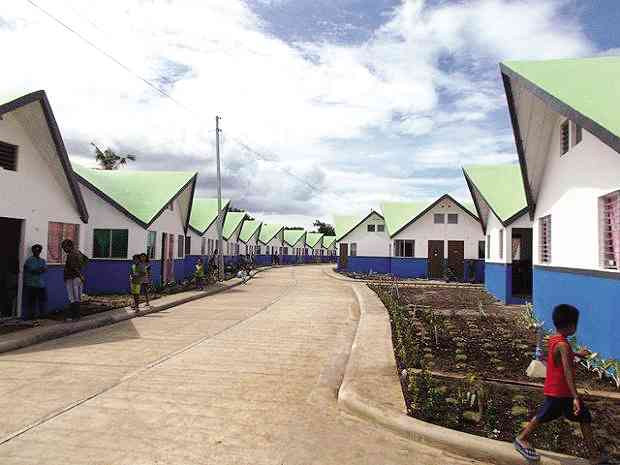Decent housing essential to inclusive growth

PDP 2017-2022 offers the promise of socioeconomic resilience by helping reduce the worsening housing backlog.
There has always been a pressing recognition on the importance of housing and urban development.
The administration’s medium term plan—the Philippine Development Plan 2017-2022—underscores the significance of healthy housing conditions and well planned urban development in achieving inclusive growth, a high-trust society, and a globally competitive economy.
The PDP 2017-2022 approved by the board of the National Economic and Development Authority (Neda) last month identified housing as one of the nine priority sectors “with the greatest potential” to help the government realize its goals under the Ambisyon 2040.
Ambisyon 2040 describes the kind of life that people want to live, and how the country will be by 2040.
Based on the latest PDP document posted on the Neda website, “the quality of shelter and the kind of communities where people live can be both a source of vulnerability and a means to enhance development opportunities and improve human development outcomes.”
“Housing and urban development become increasingly important as the economy grows, attracting people to urban areas where the opportunities are found. If not managed well, urbanization can pose risks to health, life, and property and compound natural hazards that cause disasters,” it stated.
Social malaise
While the concerns on affordable housing have merited significant attention in past administrations, the problems however continue to linger, and the roadblocks seem to have become even more challenging, to the point that inadequate access to housing has become a social malaise of sorts.
There is a seeming discord between the plans and how the policies are actually being carried out on the ground.
Be it because of unnecessary bureaucracies, conflicting regulations, natural disasters, or scarcity of suitable land, which make the business of socialized housing all the more unattractive for investors.

The Duterte administration is targeting to deliver direct housing assistance to 1.6 million households from 2017 to 2022.
One need only to look at the numbers to have a full grasp of the reality on the ground.
Based on the PDP, the country’s housing requirements remained enormous at about 6.8 million units for the period 2017 to 2022, with a housing backlog (accumulated need) of 2.02 million as of end 2016.
“Expanding access to decent, affordable, and secure shelter, particularly in urban areas, has been difficult for the housing sector primarily due to rapid urbanization and limited availability of suitable and affordable land,” the PDP read.
“As of 2011, there is an estimated 1.5 million informal settler families (ISFs) nationwide, of which 584,425 ISFs or about 39 percent are in Metro Manila,” it further stated.
Socioeconomic resilience
So what does the PDP 2017-2022 offer?
For one, it offers the promise of socioeconomic resilience by helping reduce the worsening housing backlog.
This is anchored on one of the goals set under the new PDP, which was to build safe and secure communities, and to strengthen housing as a platform to reduce poverty and improve social outcomes.
To be specific, the Duterte administration is targeting to deliver direct housing assistance to 1.6 million households from 2017 to 2022, through its various housing agencies.
Indirect housing provision will be provided by the different state agencies, which are expected to assist more than 1.58 million households over the plan period.
Further, the Housing and Land Use Regulatory Board (HLURB) will continue to assist local governments in the formulation of Comprehensive Land Use Plans (CLUPs).
Strategies
Key strategies were also identified in the PDP to help the government achieve its targets in building safe and secure communities. These include:
Developing integrated neighborhoods and sustainable communities particularly for low-income households, through the implementation of the National Spatial Strategy;
Intensifying implementation of alternatives and innovative solutions—such as public rental housing, mixed-income housing development, housing microfinance initiatives—in addressing the housing needs of the lower income classes and vulnerable sector;
Strengthening decentralization of housing and urban development interventions;
Fast-tracking inventory of lands and cadastral surveys to hasten the process of identifying land for housing projects;
Institutionalizing in the national budget process a programmatic and convergent approach to planning and budgeting for housing and resettlement interventions; and
Strengthening partnerships with stakeholders to, among others, encourage public-private partnerships (PPPs) for housing projects and improve the compliance of developers to the policy of balanced housing development.
It will definitely take more than one administration to adequately address the challenges hounding the local housing sector.
The problems had persisted for decades now and many administrations had attempted to take a stab at it.
And it cannot be blamed on the lack of policies as numerous measures had been rolled out in the past. But these seem to have fallen short of expectations. The woes of socialized housing remained just as overwhelming and massive as ever.
Evidently, it’s not just about having the right plan.
It’s more importantly about the alignment of goals and the concerted effort among state agencies, and the political will to follow through a concise, rational, and well thought out plan.














